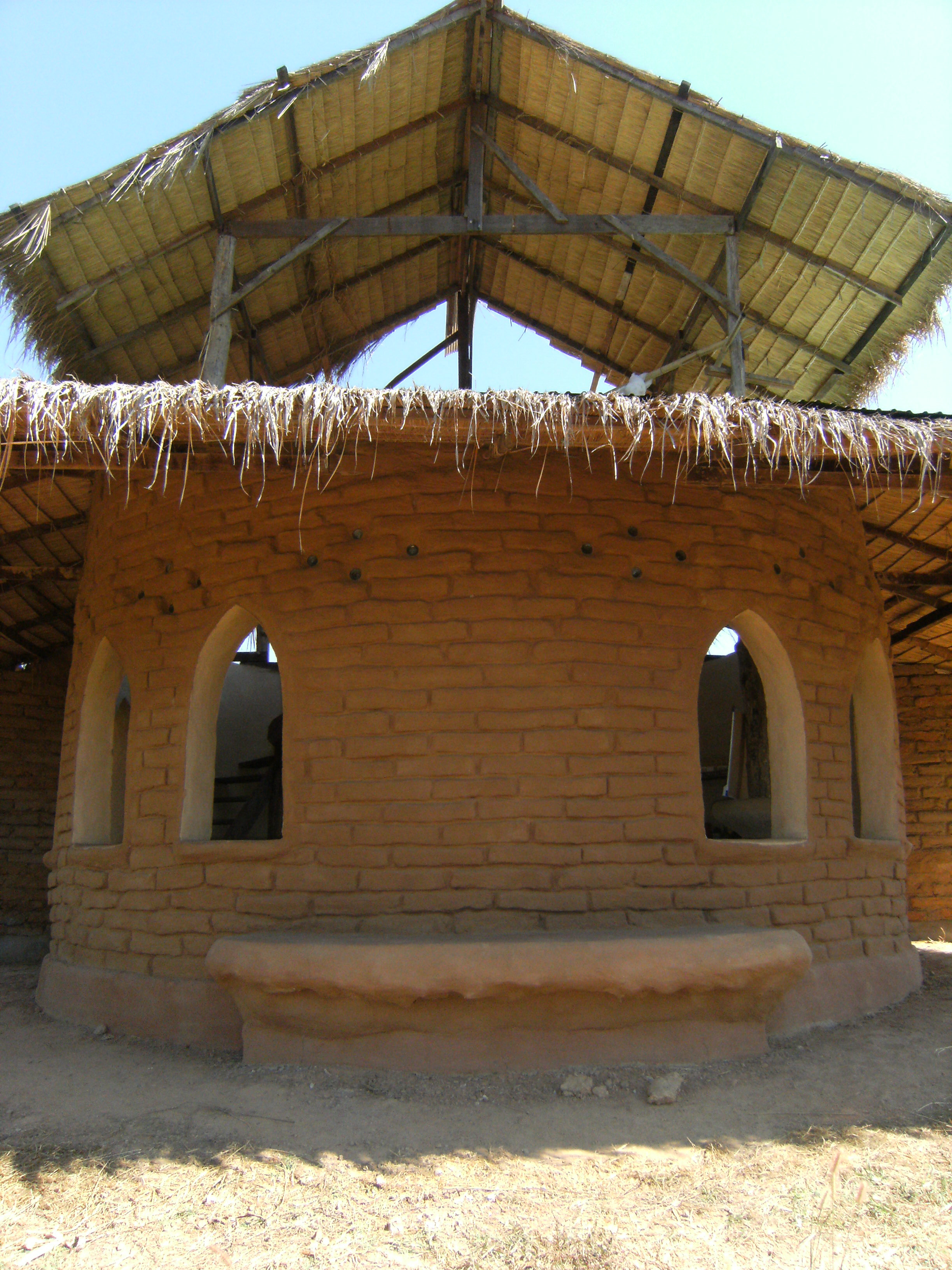การศึกษาปัจจัยช่องเปิดของบ้านดินต่อความสามารถในการรับแรงแผ่นดินไหว
Main Article Content
บทคัดย่อ
บ้านดินที่ปลูกสร้างด้วยระบบผนังรับน้ำหนักอิฐดินดิบ เป็นระบบโครงสร้างที่ง่ายต่อการเสียหายจากแรงแผ่นดินไหว จากสถิติที่ผ่านมาพบว่าอาคารประเภทนี้ก่อให้เกิดการสูญเสียมากมายทั้งต่อชีวิตและทรัพย์สิน โดยเฉพาะอย่างยิ่งในประเทศที่กำลังพัฒนา เนื่องจากก่อสร้างง่าย ราคาไม่สูงและไม่ใช้ทักษะมาก ปัจจุบันการปลูกสร้างบ้านดินในประเทศไทยได้รับความนิยมเป็นอย่างสูง โดยเฉพาะบริเวณพื้นที่ทางภาคเหนือของประเทศ ซึ่งเป็นพื้นที่เสี่ยงภัยแผ่นดินไหวตามกฎหมายกำหนด งานวิจัยนี้มีวัตถุประสงค์ศึกษาปัจจัยของช่องเปิดที่ส่งผลต่อความสามารถในการรับแรงแผ่นดินไหวของอาคารผนังรับน้ำหนักอิฐดินดิบผังรูปทรงกลมและผังรูปทรงสี่เหลี่ยมจัตุรัส โดยดำเนินการทดสอบหุ่นจำลองบ้านดินของสองรูปทรงตามมาตราส่วน 1:3
ทั้งแบบผนังทึบและแบบมีช่องเปิด ด้วยวิธีโต๊ะที่ปรับเอียงตามทฤษฎีแรงสถิตเทียบเท่า โดยน้ำหนักของหุ่นจำลองถูกแปลงเป็นแรงกระทำด้านข้างเพื่อประเมินความสามารถในการต้านแรงแผ่นดินไหวของแต่ละรูปทรง ผลการศึกษาพบว่ารูปทรงอาคารและช่องเปิดนั้นเป็นปัจจัยสำคัญต่อความสามารถในการต้านแรงแผ่นดินไหวของอาคารที่สร้างด้วยระบบผนังรับน้ำหนักอิฐดินดิบ โดยหุ่นจำลองรูปทรงกลมนั้นมีความสามารถในการต้านแรงแผ่นดินไหวที่ดีกว่ารูปทรงสี่เหลี่ยมจัตุรัส และการมีช่องเปิดของหุ่นจำลองนั้นส่งผลดีต่อความสามารถในการรับแรงแผ่นดินไหว เนื่องจากทำให้น้ำหนักโดยรวมของหุ่นจำลองนั้นเบาลง ส่งผลให้ความสามารถในการรับแรงกระทำด้านข้างสูงสุดของโครงสร้างนั้นมากขึ้น ทั้งนี้บ้านดินที่สร้างในพื้นที่เสี่ยงภัยแผ่นดินไหวจึงควรพิจารณาเรื่องการลดน้ำหนักของอาคาร และการออกแบบรูปทรงอาคารเป็นผังรูปทรงกลม เพื่อลดความเสียหายของอาคาร และความสูญเสียทั้งชีวิตและทรัพย์สินที่จะเกิดจากภัยพิบัติแผ่นดินไหวในอนาคต
Article Details
เอกสารอ้างอิง
Arros, J. K. (2003). Dynamics of structures. In Chen, W. F. & Scawthorn, C. (Eds.). Earthquake engineering handbook. (pp.105-106). Boca Raton: CRC Press.
Blondet, M., et al. (2011). Earthquake-resistant construction of adobe buildings: a tutorial. In Charleson, A. (Ed.). California: Earthquake Engineering Research Institute.
Boonyachut, S. (2006). Karn oakbab khrongsang phuea rab raeng phaendinwai. (In Thai) [Seismic design of structures]. Bangkok: Paliving Printing.
Department of Public Works and Town & Country Planning. (2018). Mattrathan karn oakbab arkhan tanthan karn sansathuean khong phaendinwai. (In Thai) [Earthquake resistant building design standards]. Bangkok: S.P.M. printing.
Earthquake Observation Division. (2020). Sathiti khomun phaendinwai tee mee phonkrathob tor prathet Thai. (In Thai) [Statistics of earthquake that affect Thailand]. Retrieved May 23, 2020, from https://earthquake.tmd.go.th/home.html
Ginell, W.S. & Tolles, E.L. (2013). Seismic stabilization of historic adobe structures. Journal of the American Institute for Conservation, 39 (1), 147-163.
Houben, H. & Guillaud, H. (1994). Earth construction-A comprehensive guide. London: ITDG.
Jandai, J. (2012). Yu kab din :16 pi karn pan din pen ban. (In Thai) [Living with the soil: 16 years molding clay as a house]. Chiang Mai: Pun Pun.
Jinwuth, W. (2017). Ban din tan phaendinwai. (In Thai) [Seismic Resistance of Adobe Building]. Proceeding of Naresuan research conference. (pp.2182-2192). Phitsanulok: Naresuan University Press.
Jinwuth, W., et al. (2010). A Study into the earthquake resistance of circular adobe buildings using static tilt tests. Proceeding of Australian earthquake engineering Society 2010 conference. (pp.1-8). Perth: The Australian Earthquake Engineering Society.
Lakkhunaprasit, P. (2014). Pattanakarn khong witsawakam phaendinwai nai prathet Thai chak adit su anakhot. (In Thai) [The development of earthquake engineering in Thailand - from the past to the future]. Proceedings of the lessons Mae Lao’s earthquake in Chiang Rai, disaster close to us. (pp.1-12). Bangkok: Department of Mineral Resources.
Minke, G. (2001). Construction manual for earthquake-resistant houses built of earth. Retrieved May 23, 2020, from http://www.gtz.de/basin.
National Information Centre of Earthquake Engineering. (2018). IITK-BMTPC Earthquake tips: learning seismic design and construction. Retrieved May 23, 2020, from https://www.nicee.org/EQTips.php.
Smith, J. W. (1941). Vibration of structures: applications in civil engineer design. Bristol: J.W. Arrowsmith.
Standards Australia. (2007). AS1170.4: Structure design actions part 4: earthquake actions in Australia. Sydney: Standards Australia.
Tolles, E. L., et al. (2000). Seismic stabilization of historic adobe buildings : final report of the Getty Seismic Adobe project. Los Angeles: The Getty Conservation Institute.
Uthaipattrakoon, T. (2004). Sang ban duai din chak din su ban. (In Thai) [Build a house with soil from the soil to the house]. Bangkok: Fueang Fa Printing.
Vargas, J. & Ottazzi, G. (1981). Investigaciones en adobe. (In Spanish) [Investigation of adobe]. Lima: Pontifical Catholic University of Peru.
Voice TV. (2014). Pramual phab kwam siahai chak het phaendinwai tee Chiang Rai. (In Thai) [Photo gallery: the damage from the earthquake in Chiang Rai]. Retrieved May 23, 2020, from https://www.voicetv.co.th/read/104843
Walker, P. & Standards Australia. (2002). The Australian earth building handbook. Sydney: Standards Australia.
Webster, F. (2002). Some thoughts on adobe codes. Retrieved August 15, 2002, from http://www.deatech.com/natural/cobinfo/adobe.html
Wojciechowska, P. (1967). Building with earth: a guide to flexible-form earthbagconstruction. N.P. : Chelsea Green Publishing.


